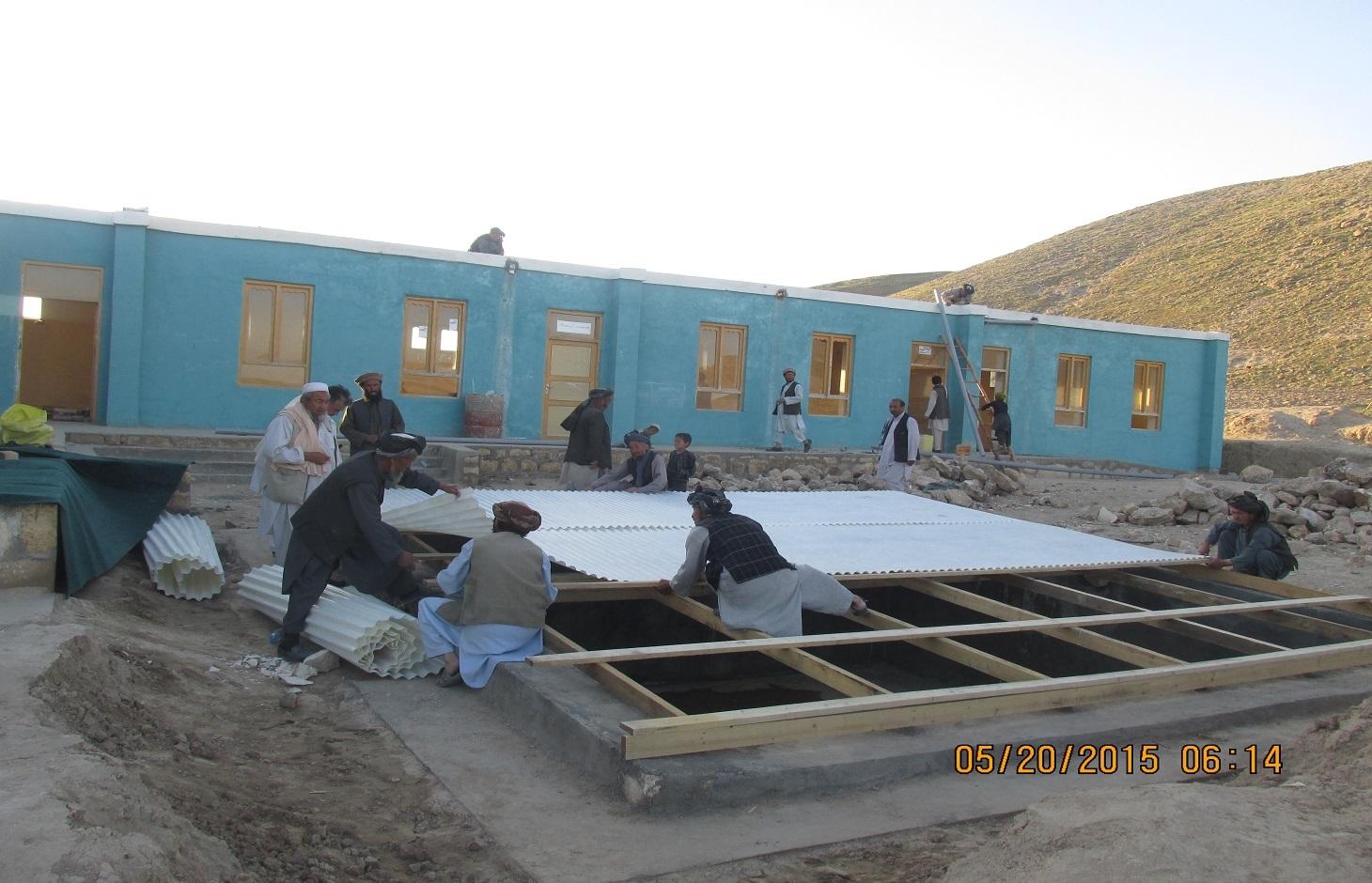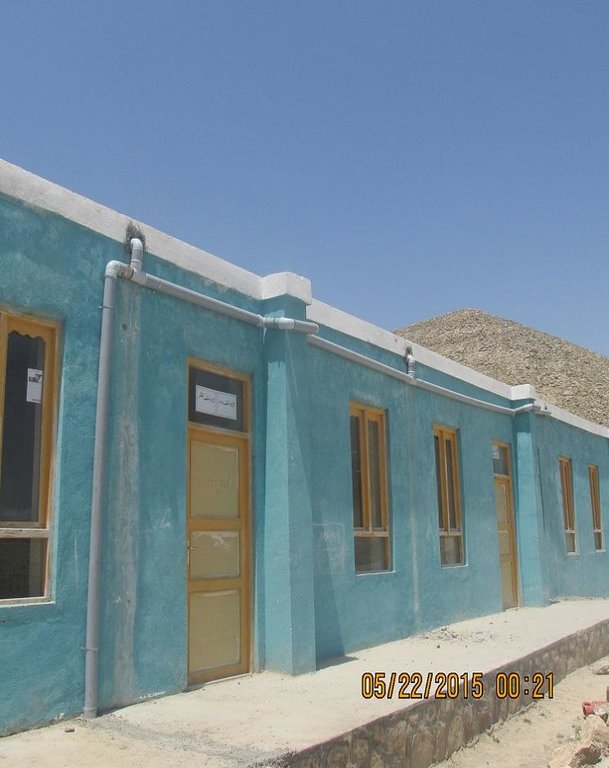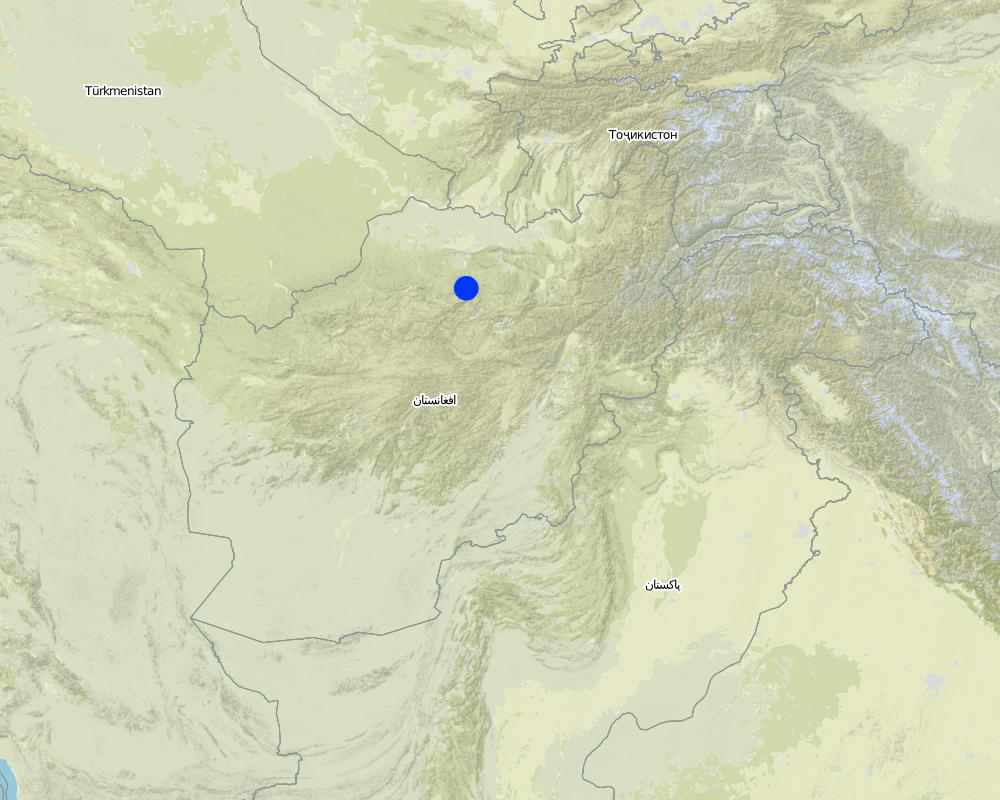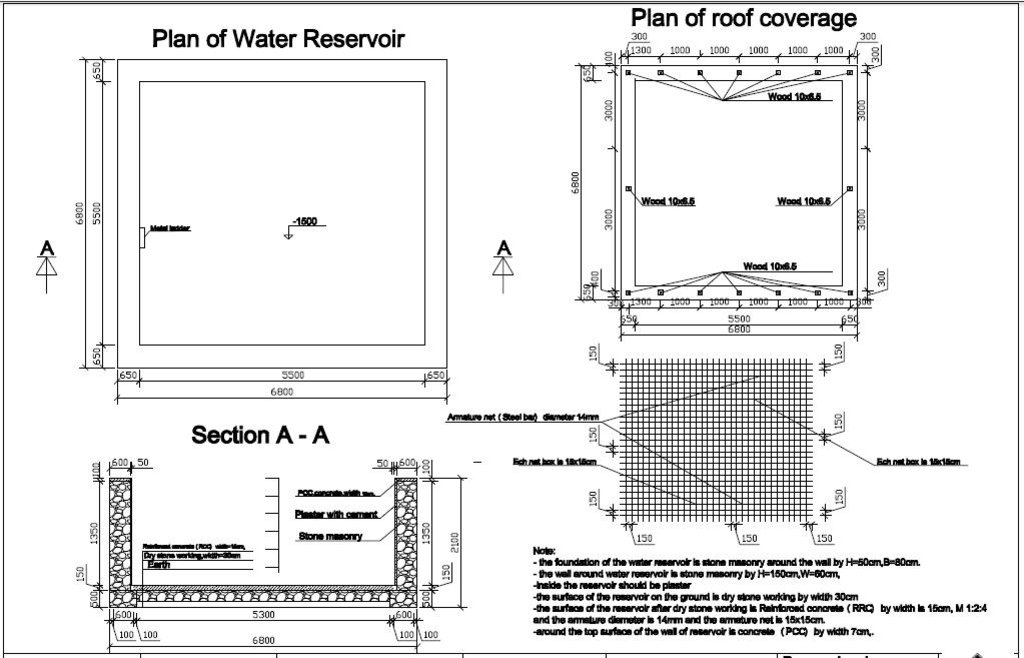Roof rain water harvesting [Afghanistan]
- Creation:
- Update:
- Compiler: Aqila Haidery
- Editor: –
- Reviewer: Alexandra Gavilano
Jam aware ab-e-baran az bam
technologies_1728 - Afghanistan
View sections
Expand all Collapse all1. General information
1.2 Contact details of resource persons and institutions involved in the assessment and documentation of the Technology
SLM specialist:
SLM specialist:
SLM specialist:
Name of the institution(s) which facilitated the documentation/ evaluation of the Technology (if relevant)
People in Need (PIN) (People in Need (PIN)) - AfghanistanName of the institution(s) which facilitated the documentation/ evaluation of the Technology (if relevant)
HELVETAS (Swiss Intercooperation)1.3 Conditions regarding the use of data documented through WOCAT
The compiler and key resource person(s) accept the conditions regarding the use of data documented through WOCAT:
Yes
2. Description of the SLM Technology
2.1 Short description of the Technology
Definition of the Technology:
Stone masonry reservoir linked with roof rain water through a pipe scheme to provide safe drinking/low cost water supply in the remote areas.
2.2 Detailed description of the Technology
Description:
Kishendeh district is extremely mountainous with low precipitation and with a shortage of water storage facilities. Underground reservoirs, called kandas, traditionally serve as water storage, catching rain water over the two/three wet months of the year for use throughout the rest of the year. The kandas tend to run out of water before the next rains come, and tend to be positioned very far away from villages in difficult to reach spots. Alika village, where this technology is implemented, suffers from the scarcity and unavailability of irrigation, livestock and even safe drinking water. Scarcity of water during the summer season makes the lives of the community members more difficult and results in their immigration from the village in the past.
Purpose of the Technology: To ease water shortage in the target community, in addition to the introduction of drought-resistant crops and soil and water conservation techniques, People in Need (PIN) has applied roof rain water harvesting technology in Alika elementary school, Alika village, Chakana cluster. The site where this technology has been applied belongs to the state. The water use right is common and poor families that do not have access to kandas are given priority for using this reservoir. The school and households near the school use this water for drinking and washing.
Establishment / maintenance activities and inputs: The project started in October, 2014 and was completed in April, 2015. For the establishment of the roof rain water harvesting technology the following inputs were used:
360 square meter tin was used to cover the roof. The pipe system is 45 meters in total. Three inch PVC pipes as well as elbows and T-joints were used. The water reservoir’s dimension of 0.80x0.50 m stone masonry foundation and 0.60x1.50x24.4 m wall; The dry stone masonry is 30cm wide; the surface of the reservoir, reinforced concrete (RCC) is 15cm wide. The reservoir was plastered with water proofing. The roof of the reservoir was constructed using wooden sketch covered with hard plastic material.
141 person/day were required for accomplishing this project. The establishment cost was 5,296$. The total value of community contribution is 7,500 Afghani/145 US$. Excavation by community members of a 50 m3 area is valued at 20,000 Afghani/385 US$. Thus the total community contribution is 10% of the total costs.
The head master of the school assumes the responsibility for maintenance. The reservoir needs to be cleaned five times a year, this is a low cost exercise. In the rainfall season it needs to be done once a month. Cleaning can be done by one person. The estimated cost for the maintenance is 500 Afghani or 10 US$ and is fully contributed by the community members.
Natural / human environment: Balkh province has a semi-arid climate and receives about 280 mm rainfall per year. The main economic activities are agriculture and livestock. The community members of the Kishendeh district have a low access to health services, employment, roads and transport and to drinking water and sanitation. Lack and scarcity of water in this village has caused many internal displacements as well.
2.3 Photos of the Technology
2.5 Country/ region/ locations where the Technology has been applied and which are covered by this assessment
Country:
Afghanistan
Region/ State/ Province:
Balkh
Further specification of location:
Kishendeh
Specify the spread of the Technology:
- evenly spread over an area
If the Technology is evenly spread over an area, specify area covered (in km2):
0.00105
If precise area is not known, indicate approximate area covered:
- < 0.1 km2 (10 ha)
Comments:
The area where the technology is applied is 35*30 m which is equal to 1050m2
Map
×2.6 Date of implementation
If precise year is not known, indicate approximate date:
- less than 10 years ago (recently)
2.7 Introduction of the Technology
Specify how the Technology was introduced:
- through projects/ external interventions
Comments (type of project, etc.):
The project started in October, 2014 and was completed in April, 2015.
3. Classification of the SLM Technology
3.1 Main purpose(s) of the Technology
- access to water
3.2 Current land use type(s) where the Technology is applied
Land use mixed within the same land unit:
No

Settlements, infrastructure
- Settlements, buildings
Comments:
Major land use problems (compiler’s opinion): Scarcity of drinking water for human and livestock consumption and as well as unavailability of irrigation water for the home gardening. Loss of roof rain water, Soil erosion, Occurrence of flash floods and environmental pollution
Major land use problems (land users’ perception): Carrying water from distant places by donkeys is very time consuming and a burden on families.
Constraints of settlement / urban: no constraints
Number of growing seasons per year: 1
Longest growing period in days: 150; Longest growing period from month to month: February till end of June
3.4 Water supply
Water supply for the land on which the Technology is applied:
- rainfed
3.5 SLM group to which the Technology belongs
- water harvesting
3.6 SLM measures comprising the Technology

structural measures
- S5: Dams, pans, ponds
3.7 Main types of land degradation addressed by the Technology

soil erosion by water
- Wt: loss of topsoil/ surface erosion

water degradation
- Hg: change in groundwater/aquifer level
Comments:
Secondary types of degradation addressed: Hg: change in groundwater / aquifer level
Main causes of degradation: disturbance of water cycle (infiltration / runoff), Heavy / extreme rainfall (intensity/amounts), population pressure
Secondary causes of degradation: poverty / wealth
3.8 Prevention, reduction, or restoration of land degradation
Specify the goal of the Technology with regard to land degradation:
- reduce land degradation
- restore/ rehabilitate severely degraded land
Comments:
Secondary goals: mitigation / reduction of land degradation
4. Technical specifications, implementation activities, inputs, and costs
4.1 Technical drawing of the Technology
Technical specifications (related to technical drawing):
Detailed technical drawing of the water reservoir constructed for roof rain water harvesting in Alika village, Kishendeh district.
Location: Alika village. Kishendeh district, Balkh province
Technical knowledge required for field staff / advisors: high
Technical knowledge required for land users: moderate
Main technical functions: water harvesting / increase water supply
Secondary technical functions: water spreading, improvement of water quality, buffering / filtering water
Structural measure: Water reservoir
Author:
Eng. Saboor Popal, People In Need (PIN)
4.2 General information regarding the calculation of inputs and costs
Specify currency used for cost calculations:
- USD
Indicate average wage cost of hired labour per day:
5
4.3 Establishment activities
| Activity | Timing (season) | |
|---|---|---|
| 1. | Excavation of the foundationConstruction of the reservoirExtending pipes from roof coverage to the reservoir |
4.4 Costs and inputs needed for establishment
| Specify input | Unit | Quantity | Costs per Unit | Total costs per input | % of costs borne by land users | |
|---|---|---|---|---|---|---|
| Labour | Excavation of the foundation Construction of the reservoir | persons/day | 141.0 | 5.0 | 705.0 | 10.0 |
| Equipment | Tools and pipes | ha | 1.0 | 344.0 | 344.0 | |
| Construction material | Cement | bags | 1.0 | 376.0 | 376.0 | |
| Construction material | Stone | m3 | 159.575 | 24.25818 | 3871.0 | 10.0 |
| Total costs for establishment of the Technology | 5296.0 | |||||
| Total costs for establishment of the Technology in USD | 5296.0 | |||||
Comments:
Duration of establishment phase: 7 month(s)
4.5 Maintenance/ recurrent activities
| Activity | Timing/ frequency | |
|---|---|---|
| 1. | Cleaning of the reservoir (5 times a year) | 5 times a year |
4.6 Costs and inputs needed for maintenance/ recurrent activities (per year)
| Specify input | Unit | Quantity | Costs per Unit | Total costs per input | % of costs borne by land users | |
|---|---|---|---|---|---|---|
| Labour | Cleaning of the reservoir | persons/day | 1.0 | 50.0 | 50.0 | 100.0 |
| Total costs for maintenance of the Technology | 50.0 | |||||
| Total costs for maintenance of the Technology in USD | 50.0 | |||||
4.7 Most important factors affecting the costs
Describe the most determinate factors affecting the costs:
Labor, cement and stone are the main factors affecting the total cost. After couple of years as well pipes may require to be changed.
5. Natural and human environment
5.1 Climate
Annual rainfall
- < 250 mm
- 251-500 mm
- 501-750 mm
- 751-1,000 mm
- 1,001-1,500 mm
- 1,501-2,000 mm
- 2,001-3,000 mm
- 3,001-4,000 mm
- > 4,000 mm
Agro-climatic zone
- semi-arid
Thermal climate class: temperate
5.2 Topography
Slopes on average:
- flat (0-2%)
- gentle (3-5%)
- moderate (6-10%)
- rolling (11-15%)
- hilly (16-30%)
- steep (31-60%)
- very steep (>60%)
Landforms:
- plateau/plains
- ridges
- mountain slopes
- hill slopes
- footslopes
- valley floors
Altitudinal zone:
- 0-100 m a.s.l.
- 101-500 m a.s.l.
- 501-1,000 m a.s.l.
- 1,001-1,500 m a.s.l.
- 1,501-2,000 m a.s.l.
- 2,001-2,500 m a.s.l.
- 2,501-3,000 m a.s.l.
- 3,001-4,000 m a.s.l.
- > 4,000 m a.s.l.
5.3 Soils
Soil depth on average:
- very shallow (0-20 cm)
- shallow (21-50 cm)
- moderately deep (51-80 cm)
- deep (81-120 cm)
- very deep (> 120 cm)
Soil texture (topsoil):
- coarse/ light (sandy)
Topsoil organic matter:
- low (<1%)
If available, attach full soil description or specify the available information, e.g. soil type, soil PH/ acidity, Cation Exchange Capacity, nitrogen, salinity etc.
Soil fertility is low
Soil drainage / infiltration is medium
Soil water storage capacity is low
5.4 Water availability and quality
Ground water table:
> 50 m
Availability of surface water:
poor/ none
Water quality (untreated):
poor drinking water (treatment required)
5.5 Biodiversity
Species diversity:
- low
5.6 Characteristics of land users applying the Technology
Off-farm income:
- 10-50% of all income
Individuals or groups:
- groups/ community
Gender:
- men
Indicate other relevant characteristics of the land users:
Land users applying the Technology are mainly disadvantaged land users
Difference in the involvement of women and men: In Afghanistan the constructional and heavy physical activities which are done outside of the houses are mainly done by men.
Population density: 10-50 persons/km2
Annual population growth: 2% - 3%
Relative level of wealth: rich, average, poor
5% of the land users are rich.
55% of the land users are average wealthy.
40% of the land users are poor.
5.7 Average area of land used by land users applying the Technology
- < 0.5 ha
- 0.5-1 ha
- 1-2 ha
- 2-5 ha
- 5-15 ha
- 15-50 ha
- 50-100 ha
- 100-500 ha
- 500-1,000 ha
- 1,000-10,000 ha
- > 10,000 ha
Is this considered small-, medium- or large-scale (referring to local context)?
- small-scale
5.8 Land ownership, land use rights, and water use rights
Land ownership:
- state
Land use rights:
- communal (organized)
Water use rights:
- communal (organized)
5.9 Access to services and infrastructure
health:
- poor
- moderate
- good
education:
- poor
- moderate
- good
technical assistance:
- poor
- moderate
- good
employment (e.g. off-farm):
- poor
- moderate
- good
markets:
- poor
- moderate
- good
energy:
- poor
- moderate
- good
roads and transport:
- poor
- moderate
- good
drinking water and sanitation:
- poor
- moderate
- good
financial services:
- poor
- moderate
- good
6. Impacts and concluding statements
6.1 On-site impacts the Technology has shown
Socio-economic impacts
Production
product diversity
Water availability and quality
drinking water availability
water availability for livestock
water quality for livestock
irrigation water availability
irrigation water quality
demand for irrigation water
Income and costs
expenses on agricultural inputs
workload
Socio-cultural impacts
food security/ self-sufficiency
health situation
community institutions
SLM/ land degradation knowledge
situation of socially and economically disadvantaged groups
livelihood and human well-being
Comments/ specify:
It has provided the access to drinking water for human beings and livestock. As well as it provides irrigation water to kitchen gardens for the HHs who lives near by the Alika Elementary School.
Ecological impacts
Water cycle/ runoff
water quantity
water quality
harvesting/ collection of water
surface runoff
evaporation
Climate and disaster risk reduction
drought impacts
6.3 Exposure and sensitivity of the Technology to gradual climate change and climate-related extremes/ disasters (as perceived by land users)
Gradual climate change
Gradual climate change
| Season | increase or decrease | How does the Technology cope with it? | |
|---|---|---|---|
| annual temperature | increase | not well |
Climate-related extremes (disasters)
Meteorological disasters
| How does the Technology cope with it? | |
|---|---|
| local rainstorm | well |
| local windstorm | well |
Climatological disasters
| How does the Technology cope with it? | |
|---|---|
| drought | not well |
Hydrological disasters
| How does the Technology cope with it? | |
|---|---|
| general (river) flood | well |
Other climate-related consequences
Other climate-related consequences
| How does the Technology cope with it? | |
|---|---|
| reduced growing period | not known |
6.4 Cost-benefit analysis
How do the benefits compare with the establishment costs (from land users’ perspective)?
Short-term returns:
negative
Long-term returns:
positive
How do the benefits compare with the maintenance/ recurrent costs (from land users' perspective)?
Short-term returns:
positive
Long-term returns:
positive
Comments:
Once roof rain water harvesting project is implemented and constructed in a place, It will not need much recurrent costs.
6.5 Adoption of the Technology
- 1-10%
If available, quantify (no. of households and/ or area covered):
24 households covering 10 percent of stated area
Of all those who have adopted the Technology, how many did so spontaneously, i.e. without receiving any material incentives/ payments?
- 0-10%
Comments:
24 land user families have adopted the Technology with external material support
Comments on spontaneous adoption: The land users has not implemented the technology with the same specifications but has implemented it with using their own available local materials.
There is a moderate trend towards spontaneous adoption of the Technology
6.7 Strengths/ advantages/ opportunities of the Technology
| Strengths/ advantages/ opportunities in the compiler’s or other key resource person’s view |
|---|
|
Provides low cost safe drinking water to the community members (Alika school and HHs who lives near the reservoir free of charge). Further more it provides irrigation water for the kitchen gardens in some extent. How can they be sustained / enhanced? Safe drinking water can be easily available during the winter season but during the three months of summer the water should be carefully used only for drinking. |
|
Requires minimum maintenance when constructed properly. How can they be sustained / enhanced? Pipe scheme, roof coverage area of the reservoir, should be cleaned, if any leakages occurs in the pipes or reservoir , they should be sealed. |
|
Application of the technology has provided the chance of having leisure time for the families. How can they be sustained / enhanced? Families and community members should use the water effectively. |
|
Roof rain water harvesting technology has supported the community members, economically. How can they be sustained / enhanced? Community members should take active participation in the maintenance of the reservoirs. |
6.8 Weaknesses/ disadvantages/ risks of the Technology and ways of overcoming them
| Weaknesses/ disadvantages/ risks in the compiler’s or other key resource person’s view | How can they be overcome? |
|---|---|
| This technology is difficult to be applied without external financial support. | Adoption of local materials should be promoted and as well as reservoirs be properly cleaned after the heavy rainfalls. |
| Technical knowledge is required for the application of this technology. | The technical knowledge should be transferred to the extension workers or local people to provide technical support in the future. |
| During the drought season with no rain fall enough water cannot be harvested inside the reservoir. | Water can be transferred to this reservoir through water tanks from other villages. |
| Social conflicts can occur during the distribution of water. | Meetings and awareness sharing events should be held. Water in keeper can be introduced by CDCs for the distribution of water. |
7. References and links
7.1 Methods/ sources of information
Links and modules
Expand all Collapse allLinks
No links
Modules
No modules






